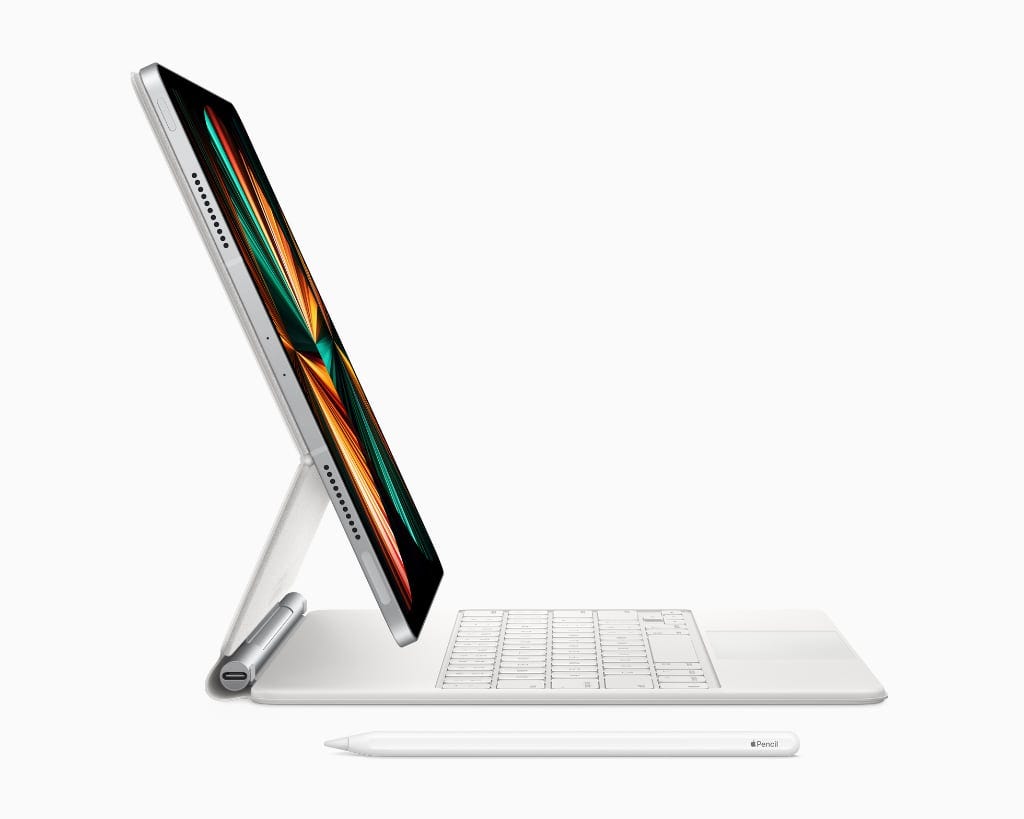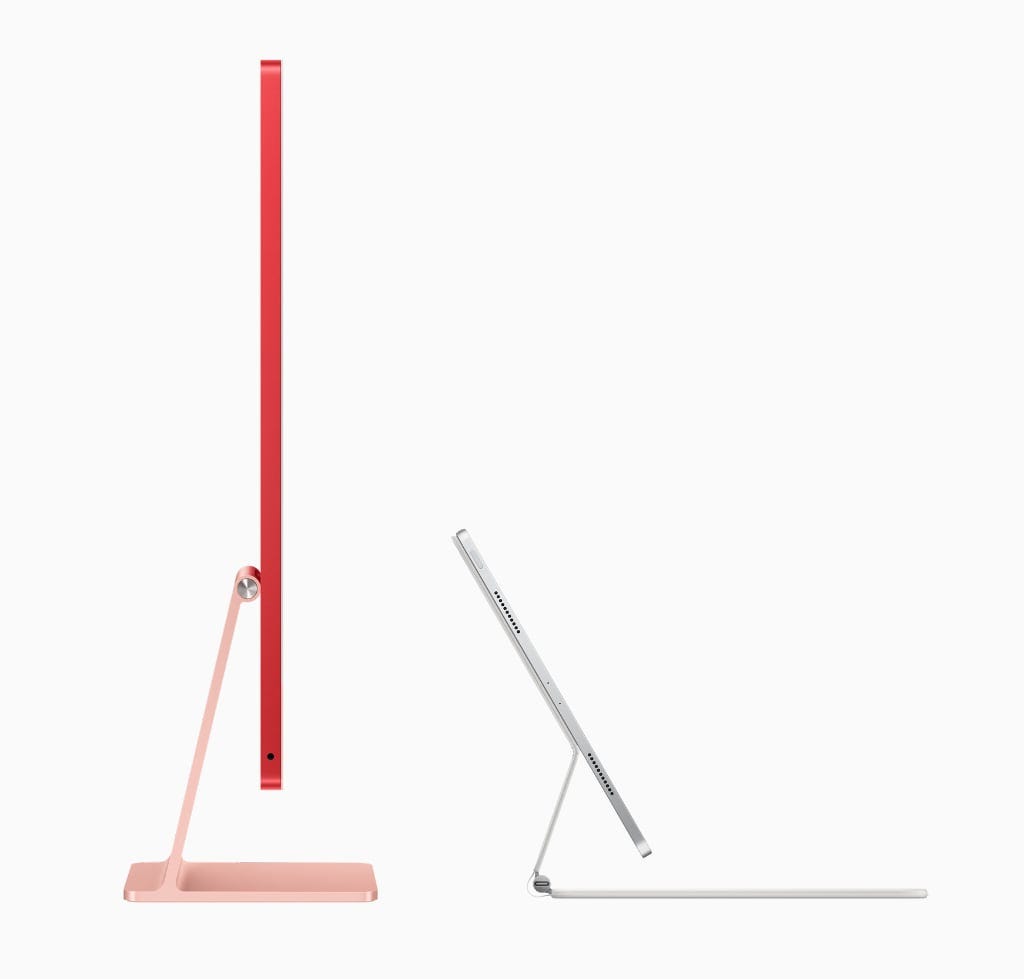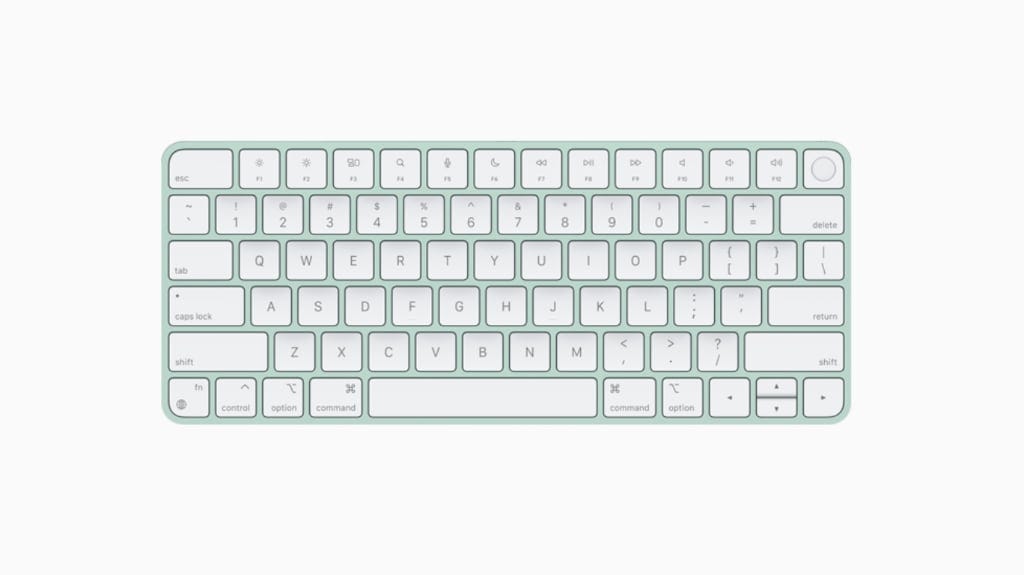🆓 This member post is free for all, thanks to our paying subscribers. Enjoy!
Hello!
Apple held its Spring Loaded event two days ago, and it was a treat for anyone eying a new iPad Pro. In fact, the iPad Pro took such a centre stage that Apple announced colorful M1 iMacs, and the much-rumored AirTag accessory, before even getting to the iPad Pros.
I’ve been thinking a lot about what they announced, rather than just rushing to posting something as I initially had planned. There’s a ton of recaps out there, you’ve probably read some of them, seen some videos where video producers are gushing over the ridiculous power-bump the iPad Pros received, and they’re not wrong being enthusiastic, optimistic even.
Let’s dive into the iPad Pro details right away. First of all, it’s still two sizes so the 11” isn’t going anywhere this year, despite the iPad Air’s existence. They look and weigh the same as previous years, so if you’re on a 2018 or 2020 model, expect to be able to use the same Apple Pencil or Magic Keyboard with your new purchase.
Both iPad Pro models get the M1 chip, which isn’t surprising but still pretty great. Combined with the fact that Apple are bumping the RAM — 16 GB in 1 TB and 2 TB models, 8 GB in lower storage options — and you’re basically looking at M1 MacBook Air parity in power here. Except you get a touchscreen on your iPad Pro, and the snappiness of iPadOS. I’d hoped this would mean even better battery life — an M1 MacBook Air outperforms my iPad Pro, which seems magical and weird, in that area — but Apple are still talking all-day battery, so I guess not. And yes, there’s a 2 TB option now too.
The new iPad Pros all have Wi-Fi 6, and the USB-C port is now actually Thunderbolt, which is nice. The iPad Pro can now power the crazy expensive XDR display if you want it to. If you’re going for the cellular version, you get 5G now too. Finally, there’s a new TrueDepth camera with 1080p support at 25, 30, or 60 frames per second. The new Center Stage feature, which tracks you and your fellow humans by zooming in and out, basically acting like a camera operator, looks really promising. Center Stage is available as an API too, but don’t expect it to hit other video conferencing apps than FaceTime anytime soon. For shots, the camera has a 12 MP wide and a 10 MP ultra-wide camera, which is up one camera from before. The TrueDepth camera is also 12 MP ultra-wide now, another bump.
There’s a perk for the 12.9” model, and that’s the new Liquid Retina XDR display. This is the rumored Mini-LED update, and it proved to be true. It’s crazy by the numbers, with 10,000 Mini-LEDs, 2596 dimming zones, 1,000,000 to 1 contrast ratio, and 1,000 nits screen brightness. Those numbers are staggering. By comparison, the 11” model has 600 nits, also a pretty strong screen. The iPad Pro screens have been outstanding from the beginning, but this new Liquid Retina XDR display sure sounds like something else, and given Apple’s track record, I’m inclined to believe the hype.
But what do those numbers mean?
- The 2021 M1 CPU is 50% faster than the 2020 A12Z.
- Graphics in the M1 is supposed to be 40% faster than the A12Z.
- Thunderbolt transfer speeds are up to 40 Gbps, when peripherals support it, which might not speed up your SD card transfers (unless you got a wicked fast adapter and card), but will do wonders for Thunderbolt hard-drives for example. And you can connect the Pro Display XDR with full 6K resolution, which is fun, but not exactly reasonable given the state of external display support in iPadOS.
It’s a serious upgrade, as we’re used to by now. The 12.9” Liquid Retina XDR display is the killer though, which makes it a shame that we’re not getting it on the 11” model.
Should you upgrade to a 2021 iPad Pro?
This is always the tricky question, but it’s easier than ever to answer.
- First of all, are you using an iPad Pro model today? If not, but you want to, then yes, of course you should upgrade.
- Second, assuming you are using an iPad Pro model today, is it the size, as in screen and storage, that you need? If not, of course you should upgrade.
It gets a little muddier after that.
- Is your iPad Pro model from 2018? Then yeah, maybe it’s time to upgrade, but honestly, unless you use your iPad Pro for seriously intense things, the 2018 more than holds its own. Older models aren’t getting any worse just because there are better ones available, and these new iPad Pros feels ridiculously overpowered for so many things people are using these devices for.
- Is your iPad Pro model of the 2020 variety? Then you better be pretty flush with cash, or use it for very demanding things where the new M1 chip and added RAM gets put to the test because the 2020 iPad Pro is crazy fast.
- Are you an iPad nerd that really wants that new Liquid Retina HDR screen on your iPad? Yeah, upgrade if you can afford it.
- Are you, for whatever reason, upgrading to future-proof yourself? This I don’t understand because unless you need more power, or is disappointed in the current screen, then why buy something for needs you might not ever have?
How expensive did it get?
Both the 11” and the 12.9” start at 128 GB storage, and goes up to 2 TB each in increments. The base models, Wi-Fi only, start $799 and $1099 respectively ($999 and $1299 if you want cellular too). If you want that additional RAM you need to get at least the 1 TB model, which is $1499 and $1799 respectively ($1699 and $1999 for cellular). Maxing it out with 2 TB is $1899 and $2199, or $2099 and $2399 if you need cellular.
$2399 is a lot of money for a maxed-out 12.9” iPad Pro. The $300 premium for cellular is perhaps worth less than ever thanks to the pandemic, so there’s money to save there, but personally I like the safety net it gives me. 4G speeds are more than decent where I live, many of my friends rely on cellular broadband rather than wired to save money, and 5G is spreading too. Then again, chances are your phone can act as a hotspot, and $300 is a lot of money, so choose wisely.
But why put all this power in an iPad?
Let’s be clear here: The 2020 iPad Pro models are crazy fast and powerful. They constantly outperformed my old Intel MacBook Pro in overall snappiness, battery-life, but also things like 4K rendering. With M1 Macs, the MacBook Air now does these things just as well, if not better, and it doesn’t feel like I’m on the superior device anymore. The more versatile platform, sure, but power-wise, M1 put the Macs in front again.
M1 iPad Pros levels the playing field. Now you pick your device based on the platform and interaction models, and for me, personally that further underlines the iPad as the more enjoyable computing device. After all, it’s what Switch to iPad is all about, so I applaud this move. That said, I’m not saying everyone should nor need to buy an M1 iPad Pro because chances are you don’t need that sort of power. It’s good that it exists, don’t get it until you need to upgrade, for whatever reason.
The case for more power in the iPad is obviously pro apps, and professional use overall. There are a few stand-out pro apps available already, like LumaFusion for video, Affinity’s suite for designing and photos, and even Adobe with their recently released iPadOS versions of Photoshop and Illustrator. Apple clearly wants more of this, but they’re not exactly leading by example. WWDC might change that, alongside announcing more power-user updates to iPadOS. Right now, the hardware is the least of Apple’s problem, they need to get the apps and the software to keep up with it.
Bits and pieces
There’s a new Magic Keyboard too, although don’t get too excited. It’s the same model, but in white. I can see people wanting this, but how will that age? We’ll see.

Speaking of keyboards, Logitech announced a new one too. The new Combo Touch is already available in the US for the 11” model, and coming soon for the 12.9” one. It features a fully capable trackpad, and a kickstand, so this might be an option if you don’t like the look and feel of the Magic Keyboard. It’s very Surface-like, if that’s something you think is a good thing.
Logitech isn’t the only ones getting ready to release new keyboards in the wake of Apple’s event. Brydge has a new one with a snap-fit (called SnapFit case) rather than the hooks they’ve used before. Brydge 12.9 MAX+ is available for pre-order, no news on an 11” version, though.
Apple sure likes that look though because the new M1 iMac models sure shares a lot with an iPad Pro in the Magic Keyboard.

The M1 iMac comes with new color-coded keyboards too. They’re not available stand-alone yet, but are confirmed to be working with other Macs, so they’ll likely work with iPadOS as well. Except some changes to the layout, the added Touch ID sensor is a nice touch (pun intended). It’s unlikely that’ll work when connected to an iPad though, as it’s an M1 Mac feature, but perhaps it could. I’m intrigued by these keyboards, not all of us think the Magic Keyboard accessory is the best thing since sliced bread for our iPad Pros. More on this soon, I’d wager.

Other than the AirTag, Apple also announced a new version of the Apple TV 4K, running the A12 Bionic chip. It supports Bluetooth 5 and Wi-Fi 6, but perhaps the biggest news is a new Siri Remote. More buttons, less nonsense, or so it seems at least. Don’t expect to find it, or your spanking new 2021 iPad Pro for that matter, using the U1 feature like the AirTags though — that chip is in neither of these devices. That’s not a big deal for iPad Pros, you can use Find My since they’re network enabled devices, but the Siri Remote could technically go astray. To be fair, that usually involves somewhere in the couch, so it matters less.
Apple Card and the TV+ service both got mentions too. The sooner isn’t available in my region, and the latter was just trailers, but if you’re interested, hit the links.
You can watch the whole event in the TV app, or here if you prefer YouTube.
Apple events are different these days, pre-recorded and all. I like them better, they’re a lot more slick than before, and get the story across in a much reasonable 60 minutes. There’s room for a little bit of tomfoolery, but overall, it’s a sharp format. As for the announcements, I think iPad Pro users should be mostly pleased, although the 11” version is now the lesser one in more than size, and Mac people will love the new M1 iMacs. Personally, I’d hope to see a new iPad mini, but wasn’t really expecting one. It’s more likely to be an incremental update later on, or, if Apple decides it’s a key device, it’ll join the iPad Air with the new form factor at a consumer event.
What I’m getting? Well, I have to see that new iPad Pro screen, and I’m taking quite a bit of photos, so I’ll likely max out the 12.9” iPad Pro when pre-orders begin on April 30th. And new Apple TV 4Ks because I like better connectivity and speed, but could honestly just as well pick up new Siri Remotes instead. Nobody loves those old Remotes, get me the new one post-haste! If you disagree, feel free to tweet to @tdh with your arguments.
Until next time, stay safe!
— Thord D. Hedengren ⚡️
